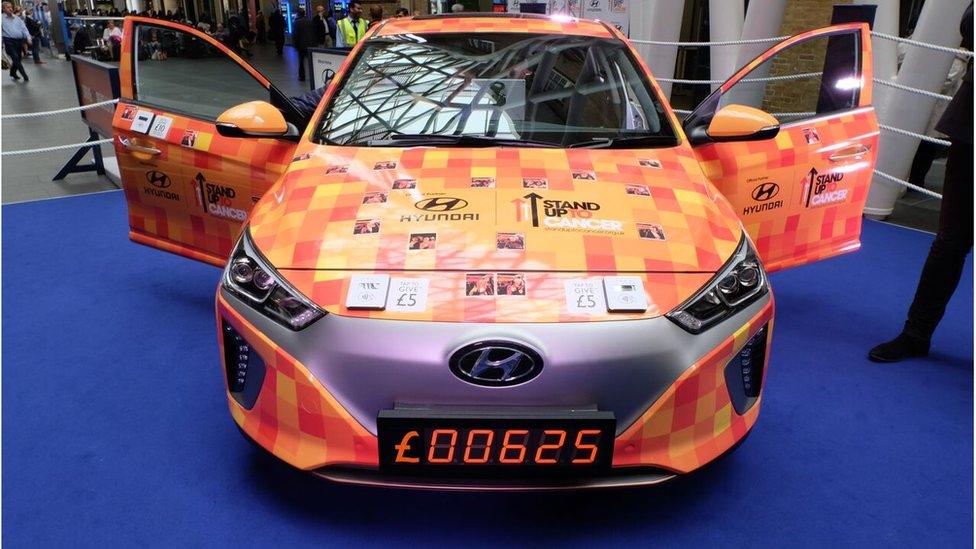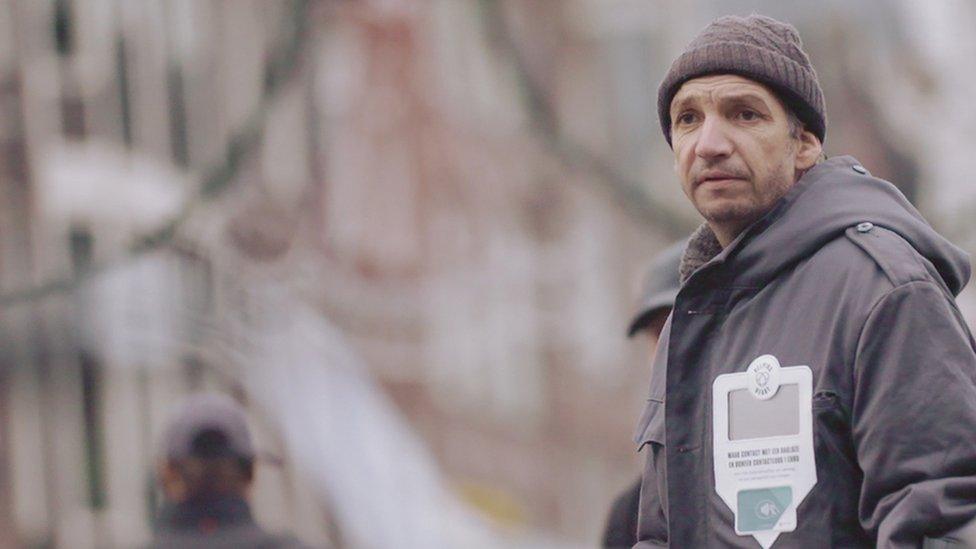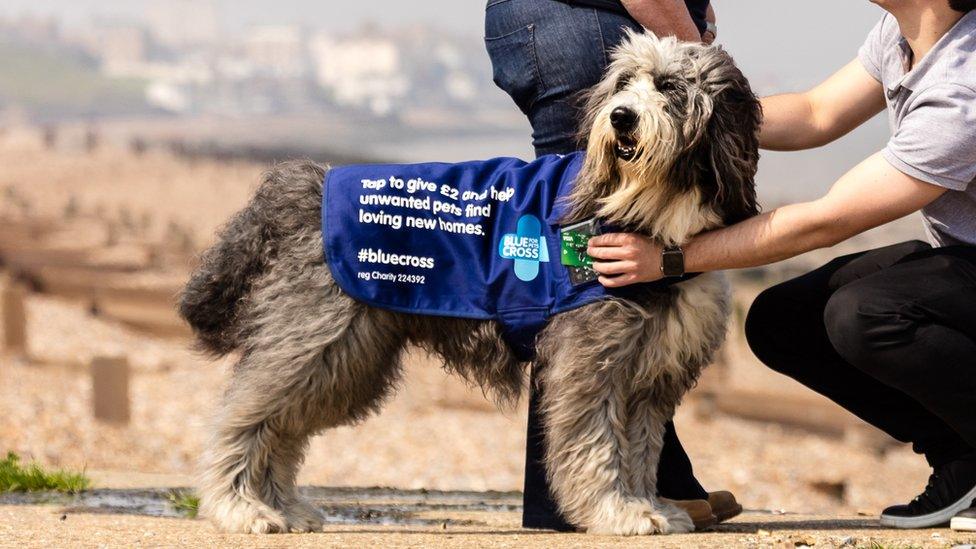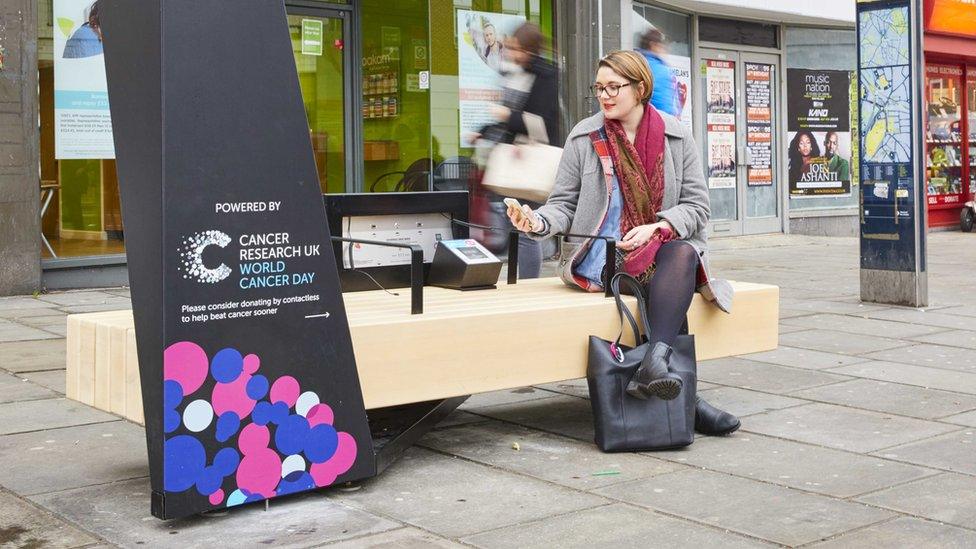Is 'tap and go' a better way to give to charity?
- Published

Stand up to Cancer and Hyundai clubbed together to make a charity donation car
A quick tap of my card and I've given Macmillan Cancer £10. It beats trying to avoid eye contact every lunch hour with a "charity mugger" or chugger.
In today's fast-paced world, although we may hate to admit it, not many people have time to chat or reel off card details to a stranger for 10 minutes.
And figures show that while cash is still very widely used, people are increasingly turning to "tap and go".
According to trade body UK Payments, contactless cards are "having a clear impact" on the use of cash in the UK.
In a world full of smartphones and contactless cards, having cash on you no longer has to be a priority.
And YouGov recently found that 34% of Brits think the UK will be cashless, external within the next 20 years.
So what future does this hold for charity donation buckets, collection tins and clip-board wielding charity reps?
Contactless donation boxes
"Today's consumers are increasingly using card and mobile payments rather than cash, and this has a knock-on impact on fundraising," says Paulette Rowe, managing director of Barclaycard Payment Solutions.
"Ten years after we introduced contactless to the UK, more than half of all transactions today - up to the £30 spending limit - are made using 'touch and go' technology."
Last year Barclaycard worked with 11 charities, including the NSPCC and the RNLI, to trial contactless donation boxes.
The lightweight, portable payment boxes look similar to cash donation boxes, but with a contactless payment point embedded in them.
More Technology of Business

The boxes were used by volunteers at events and placed at checkouts in supermarkets.
During the trial, the average donation for the NSPCC was £3.07 - higher than the average amount the charity receives through spare change.
The child protection charity also used a contactless donation box to accept a one-off gift of £1,000.
A fundraiser had given a speech about how his brother's suicide has inspired him to support Childline, and this had moved a donor in the audience to make the instant payment.
More than 40 organisations have now signed up to use the contactless donation boxes in the future.
Spare change
But with fewer people carrying cash, where does that leave people, like the homeless, who rely on loose change from kind strangers?
An Amsterdam-based company, N=5, is trying to come up with a solution with its Helping Heart jacket for the homeless.
The jacket, which was piloted in Rotterdam and Amsterdam late last year, is a warm winter coat that incorporates a payment reader and an LCD screen.

A Helping Heart jacket can collect digital donations that can be redeemed later
Passers-by can make a card donation of a set €1 with one tap of their card.
Although it could be seen as a little impersonal, the organisers hope the jacket will be a topic of conversation for both parties.
The donations could then be redeemed by the jacket wearer for food, shelter or other support, through participating homeless shelters and organisations.
"We wanted to make a real difference to those in the homeless community who are becoming increasingly excluded from our more cashless economy," Silvia van Hooft, strategy director at N=5, told the BBC.
The company is now working with other homeless charities and organisations all over the world to make the jacket available in different cities.
Pooch power
Other charities have used wearable card readers to get the attention of potential donators.
Last May, Smudge, Maverick and Ralph all helped raise money for animal welfare charity Blue Cross.
The "tap dogs" all wore coats embedded with contactless payment stations - so while you were giving Smudge a cuddle you could also donate money.

Ralph the dog wore a jacket that could be used to collect donations for Blue Cross
The contactless readers were set to accept £2 donations per tap, although dog handling volunteers can manually change the amount if the giver wants. Paypal has now joined forces with the charity to fund more card readers and dog coats.
"The dogs have been extremely popular," says Matt Cull, deputy director of fundraising at the Blue Cross.
"It hasn't had an impact on our overall fundraising, as it's been more about raising awareness, but hopefully down the line we will see it play more of a significant part."
Billboards and cars
Other charities are also embracing the new technology.
This year cancer charity Macmillan embedded contactless payment ports into giant foam hands to use at Fujitsu's World Tour.
Cancer Research UK has five "smart benches" around London that not only act as phone charging and wi-fi points but also allow people to donate with a tap of their card.
And Singapore has gone for a larger scale with smart digital billboards.
Ad agency Tribal Worldwide Singapore and charity Community Chest turned billboards into digital donation boxes.
Commuters could tap their EZ-Link cards - used to pay for public transport - on the billboards and make donations to or from work.
Environmental charities are also riding the contactless wave.
Surfers against Sewage teamed up with Visa to try and reduce plastic use at the Boardmasters music festival. Branded vending machines sold reusable aluminium water bottles for £2 each, bought with contactless devices.
Stand up to Cancer and Hyundai have also clubbed together to make a charity donation car. Passengers take a selfie and make a £5 donation to the charity.

Cancer Research has five "smart benches" around London
The car, designed by Foolproof, has five contactless payment points positioned around it and combines a number of different technologies, including Arduino microcontrollers and Raspberry Pi microcomputers.
When the car was unveiled at Kings Cross station in May it received more than 200 interactions in the first few hours of operation.
So are contactless cars and dogs that can take payments really the way forward for charities?
Missing out?
Payments UK predicts that cash will shift from being used for less than half (40%) of all payments made in 2016 to just one in five (21%) by 2026.
And Barclaycard believes that charities will miss out on £80m a year if they only accept cash donations.
Simon Black, chief executive officer of epayment company the PPRO Group, adds: "If charities don't implement alternative payment methods as a priority, they will risk being left behind by organisations who do.
"Retailers have acted swiftly to introduce contactless payments, it is now time for charities to do the same."
Follow Technology of Business editor Matthew Wall on Twitter, external and Facebook, external